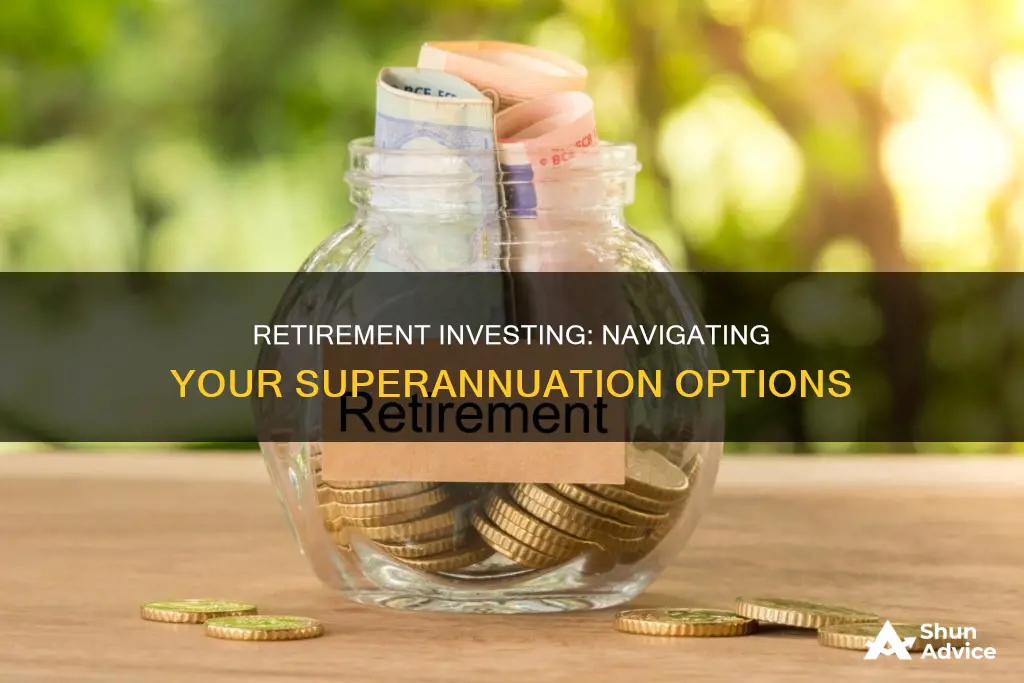
Retirement can be a complex and fluid life stage, with many retirees continuing to work and receiving income. This income can be used to grow your superannuation savings through voluntary personal contributions, employer-paid contributions, and other types of contributions.
The rules around contributing to your super after retirement depend on your age, total super balance, and previous contribution history. It's important to consider your financial goals, risk tolerance, and the potential tax implications of your decisions.
| Characteristics | Values |
|---|---|
| Preservation Age | Between 55 and 60, depending on birth year |
| Access to Government Age Pension | 67 years old |
| Options for managing retirement savings | Leave money in super account, take balance as a lump sum, start a transition to retirement strategy, open an account-based pension |
| Additional contributions | Non-concessional contributions, downsizer contributions, concessional contributions, government co-contributions, spouse contributions |
| Non-concessional contributions cap | $120,000 for 2024/25 financial year |
| Concessional contributions cap | $30,000 for 2024/25 financial year |
| Downsizer contributions | $300,000 from the sale of a home for those 55 years or older |
| Spouse contributions | Cannot be made once the recipient spouse turns 75 |
What You'll Learn

You can leave your money in your super account until you need it
Leaving your money in your super account until you need it is one of the most common options for managing your super in retirement. This option means your money remains invested, and you can continue to benefit from investment returns.
If you have other income sources or savings to live on, you might want to consider this option. Leaving your super savings in your account can be a good way to make your retirement savings last longer. For example, if you have a government pension or other investments, you may not need to access your super right away.
It's important to note that if you choose this option, you may still be able to make additional contributions to your super. If you're under 75, you can generally make voluntary personal contributions, regardless of your employment status. This can be a way to boost your retirement savings and take advantage of tax benefits. However, it's always a good idea to consult a financial adviser to understand the tax implications and contribution caps for your specific situation.
Additionally, if you're still working between the ages of 65 and 74, the rules around employer-paid super contributions don't change. You're generally eligible to receive super from your employer if you're aged over 18, regardless of whether your job is permanent or casual.
By leaving your money in your super account, you can make the most of the tax benefits associated with superannuation and give your savings the opportunity to grow. This option provides flexibility, allowing you to access your super when you need it while potentially increasing your balance over time.
Student Debt Strategies: Investing to Reduce the Burden
You may want to see also

You can take your balance as a lump sum
If you want to take your superannuation balance as a lump sum, you can withdraw your super and put it into a bank account. However, once you have done this, you may not be able to put it back into a super or retirement account later, so it is worth considering your age and the government contribution caps before making this decision.
If you choose to take your super as a lump sum, you could put your money into a savings account. However, it is important to remember that interest rates on savings accounts can change, and the rising cost of living may also affect how much money you have in the account.
Another option is to invest your money outside of super. This option can give some people a new focus once they finish work, but it also requires a high level of knowledge and expertise, and it can be time-consuming. Returns fluctuate, and you can lose money, so it is worth speaking to a financial adviser to help you decide if this option is right for you. It is also worth noting that, with this option, you won't benefit from the concessional tax rates on earnings that apply to investing in super.
A third option is to set up an SMSF (Self-Managed Super Fund). This is a means of looking after your own super savings, and potentially those of other family members. With an SMSF, you can choose your own investments, but you are responsible for complying with superannuation and tax law. All members of the SMSF must be trustees or directors of the corporate trustee. While the option to manage your own superannuation can be appealing, it involves a lot of work and can come with some risk. Although you may decide to outsource its daily administration, the SMSF is ultimately your responsibility, so professional financial, legal, and taxation advice and support are highly recommended.
Rich People: Where's the Money?
You may want to see also

You can set up an SMSF (Self-Managed Super Fund)
Setting up a Self-Managed Super Fund (SMSF) is a way to maintain control over your super savings and potentially those of other family members. An SMSF is a private super fund that you manage yourself, and it can have no more than six members. As a member, you are a trustee of the fund or can appoint a corporate trustee. In either case, you are responsible for the fund and its compliance with superannuation and tax laws.
- Decide on the structure: You can choose between an individual or corporate trustee structure. All trustees must be members of the fund, and if a corporate trustee is appointed, members must be directors of the corporate trustee.
- Appoint trustees: Ensure that all trustees meet the eligibility requirements and have them sign the trustee declaration within 21 days of consenting to become a trustee.
- Create a trust deed: This document outlines how your fund will be operated and its capabilities.
- Establish a separate bank account: Your fund must hold assets, and these assets must be kept separate from any other entity's assets.
- Register with the Australian Taxation Office (ATO): You have 60 days from establishing your fund to register with the ATO to obtain an ABN and TFN.
- Register for an Electronic Service Address (ESA): You can obtain an ESA from your SMSF administrator or apply for one from a provider.
- Develop an investment strategy: Your investment strategy should outline the fund's investment objectives and the types of investments it will make, considering the risk profiles of all members. This strategy must be in writing and regularly reviewed.
It is important to note that managing an SMSF requires significant time and financial commitment. You will need to spend time on activities such as researching investments, staying up-to-date with regulatory changes, accounting, and arranging annual audits. There are also ongoing costs associated with running an SMSF, including administration, investment, and professional fees.
While an SMSF offers control over your super savings and investments, it is essential to carefully consider the risks and responsibilities involved. As a trustee, you will be personally liable for all the fund's decisions and outcomes. Therefore, it is recommended to seek professional financial, legal, and taxation advice before establishing an SMSF.
Retirement Investment Strategies: Growing Your Nest Egg After Work
You may want to see also

You can open an account-based pension
Account-based pensions, also known as allocated pensions, are a great way to create a regular income stream from your super savings when you retire. They are flexible and tax-effective, allowing you to decide how much and how often you get paid. This means you can structure your pension payments to suit your personal retirement goals and other income streams.
Account-based pensions work by enabling you to receive regular payments from your super savings during retirement. The main appeal of account-based pensions is their flexibility and tax benefits. There's no tax payable on your investment earnings, and payments are tax-free after the age of 60.
You can customise your account-based pension to suit your needs. You can choose to be paid fortnightly, monthly, quarterly, half-yearly, or annually. You can also choose how you'd like your super to be invested. And since your money stays invested, it will continue to generate investment returns.
There is a minimum amount you must withdraw each financial year from your account-based pension, based on your age. This is called the "minimum drawdown rate". The minimum drawdown rate is set by the government and is age-based, increasing as you get older. Your minimum amount is calculated as a percentage of your account balance on 1 July each year. There is no maximum withdrawal limit.
Account-based pensions can help you keep a routine in place. They let you set up regular payments over the course of your retirement. This money is paid from your super savings, straight into your bank account for easy access. These regular payments give you control and can help you manage your finances.
You can also access extra money from your account-based pension whenever you need it. For example, you may decide to buy a new car, renovate your home, or tick off some bucket list travel plans. If you're 60 or over, both your regular income payments and additional withdrawals are tax-free.
When you open an account-based pension, your super balance stays invested with your super fund. This gives your savings the chance to keep growing and last a little longer, thanks to compound investment returns.
Worthy Investing: Unlocking Monthly Dividend Potential
You may want to see also

You can use a mix of retirement income options
When it comes to managing your super in retirement, there are several options available to you. Here are some strategies you can use to create a mix of retirement income options:
Leave your money in your super account
If you have other income sources or savings to live on, you can choose to leave your super savings in your account. This allows your money to remain invested, potentially benefiting from investment returns. This option provides flexibility and the potential for continued growth.
Take your balance as a lump sum
You have the option to withdraw your super and place it into a bank account. From there, you can explore various ways to manage your money, such as using a savings account or investing outside of super. However, once you withdraw your super as a lump sum, you may not be able to put it back into a super or retirement account later due to age and contribution cap restrictions.
Set up a Self-Managed Super Fund (SMSF)
An SMSF gives you control over managing your super savings and investment choices. It allows you to make provisions to draw an income after retirement. However, it involves significant responsibility and work, and professional advice is recommended to ensure compliance with regulations.
Transition to retirement strategy
If you plan to continue working reduced hours, a transition to retirement strategy can help balance your salary with payments from your super. This approach provides flexibility and can also reduce the amount of tax you pay on additional contributions.
Open an account-based pension
An account-based pension, such as AustralianSuper's Choice Income, keeps you in control of your super balance. It allows you to receive regular income payments while keeping your money invested, aiming for long-term returns. This option provides flexibility, tax benefits, and the potential for your super to last longer.
Make additional contributions
Even after retirement, you can make additional contributions to your super if you are under 75 years old. Non-concessional contributions of up to a certain amount per year are allowed if your total superannuation balance is below a certain threshold. You can also explore options like downsizer contributions from the sale of your home, if eligible.
Remember, it's important to consider your personal circumstances, risk tolerance, and financial goals when creating your retirement income mix. Consulting a financial advisor can help you make informed decisions and choose the most suitable options for your needs.
Is It Worth Investing in Ripple?
You may want to see also
Frequently asked questions
The retirement phase of super refers to when you change your savings from 'accumulation' to 'decumulation'. To do this, you must have reached Preservation Age (usually 60) and met the required conditions of release.
There are several options for managing your retirement savings. You can leave your money in your super account, take your balance as a lump sum, set up an SMSF (Self-Managed Super Fund), or open an account-based pension.
The Preservation Age is the minimum age you must reach before accessing your super. It varies depending on the year you were born. For those born between 1 July 1960 and 30 June 1961, the Preservation Age is 60.
An account-based pension, like AustralianSuper's Choice Income, keeps you in control of your super balance in retirement. You can take your super as a regular income payment and keep your money invested with your super fund.







